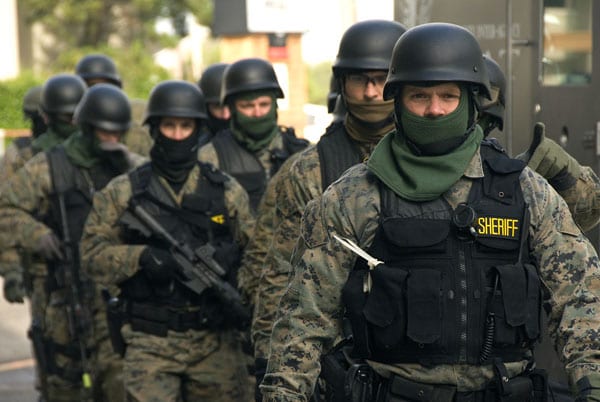
November 25, 2018; Intercept, and November 29, 2018; CityLab
Anxiety is on the rise in the US. According to Medical News Today, “anxiety disorders are the most common mental illness in the US,” affecting almost one in five people. One contributing factor may be the increased militarization of civil society, counterinsurgency tactics tested in foreign wars come back home, to be deployed at the southern (not the northern) border and in urban areas.
The Intercept’s Jeremy Scahill writes, “We are in the middle of an unprecedented paramilitarization of state and local law enforcement agencies in this country.” Referencing Bernard E. Harcourt’s book The Counterrevolution: How Our Government Went to War Against Its Own Citizens, Scahill places the US’s post-9/11 “domestic reality…within the deeper history of modern warfare and counterinsurgency doctrine.” According to Harcourt, this is the current government strategy. Scahill calls it “a counterinsurgency warfare model of politics.”
Key to this is a Defense Department program for the transference of military equipment—and, one could assume, tactics—from foreign war zones to US government agencies.
CityLab’s Tanvi Misra reports that a recent paper by sociologists Jennifer G. Correa and James M. Thomas argue that the border militarization that killed Esequiel Hernández Jr. in 1997 “evolved hand-in-hand with the rise of military-style policing in segregated US cities” that killed Michael Brown in Ferguson in 2014.
Misra continues, “Citing the scholarship of anthropologist Gilberto Rosas, the authors write that America’s urban areas are essentially a kind of ‘borderlands,’ where heavily-armed police patrol intentionally established color lines—and ‘recast black and brown bodies, immigrant and nonimmigrants alike, as exceptions and aberrations.’”
Sign up for our free newsletters
Subscribe to NPQ's newsletters to have our top stories delivered directly to your inbox.
By signing up, you agree to our privacy policy and terms of use, and to receive messages from NPQ and our partners.
The criminalization of immigration and anything associated with being black reflects the sense that, as Misra writes, “‘the border’ [has] become a vast and pliable thing.”
She concludes, “Both communities face constant surveillance and threats to the civil rights of certain residents.”
At a recent protest organized by Southern Border Communities Coalition, Joe Castillo notes, “[These are] weapons of defense against a false enemy.”
Trump inherited this system and is amplifying it. Misra says, “Whether he’s calling for troops on the border or the South Side of Chicago, the message is the same: These spaces, and the predominantly black and brown people who live in or near them, are inherently problematic, and need to be forced into submission.”
As white supremacy evolves into white nationalism and the “we” retrogrades into whiteness, how is our sector responding? Are we articulating an alternative “we” and pushing it through our practices?—Cyndi Suarez
Correction: This newswire has been altered from its initial form to correct the year in which Esequiel Hernández Jr. was shot.













